-
Posts
1,574 -
Joined
-
Last visited
Content Type
Profiles
Forums
Blogs
Gallery
Events
Store
Posts posted by Chuck In Oregon
-
-
This seems to be the 100-Year Jubilee Graduation Badge of Konstantin's Artillery School. From Alexander I to Nicholas II. The green enamel leaves in the wreath are a nice touch. I guess that's a duke's crown in the center, over the fancy K.
It is heavy bronze or brass, four pieces -- body, top crown (brazed on), wreath and the Crown K -- and two colors of enamel. There is some cracking of the white enamel and the green enamel is partly missing in four of the leaves.
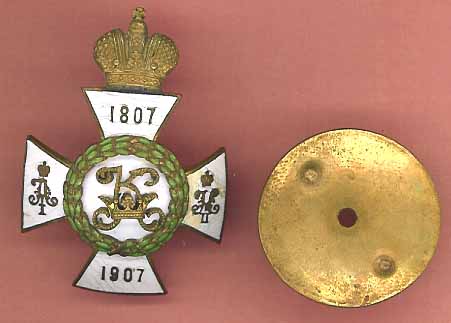


 0
0 -
Hi Chuck,
I think it originally had the crowns and they were neatly cut off.
Waste not want not..
George
* * * * *
Well, that sounds reasonable. As a commanding officer, you might want to show support to the provisional government while you were waiting for things to sort themselves out in St. Petersburg and Moscow.
"Nip off the crowns, boys. That'll do until they send us some new insignia. Should be any day now."
George, your photos are really excellent. Are you using a digital camera on a tripod? My scans are really second-rate compared to your photos. What are your tricks for such clear shots?
Chuck
0 -
There's not much to this miniature, but I think it took some effort -- and luck, and friends in the right places -- to earn one. It appears to be gilted brass. The enamel is decent, but not particularly high quality. It is not hallmarked or proofed. I think the screwback (is there another name for that device?) is silver-plated brass.



 0
0 -
Here is another variant of the RR engineer's badge, similar to the one that George posted. Similar, but with significant style differences. This badge is neither proofed nor hallmarked. It seems to be merely once-plated (if that), stamped brass, with gilt highlights on the crest.
It has three parts: the wreath, the complete eagle theme and the crossed axe and anchor. It looks like the wreath and eagle may have been stock items and the department insignia added as needed. That might suggest a late-era badge, as opposed to a silver badge, but I really don't know.
I thought about adding this to George's "Civil Breast Badges" thread. However, I finally decided to post a separate thread. In my opinion, a thread dedicated to a genre offers less to researchers than a thread dedicated to a more specific topic. In the genre thread, one may see a lot of different and interesting things, of course. But if someone wanted to research, say, Red Cross badges -- and I have some dandies to share -- then it would be a lot more tedious to wade through a general badge thread looking for them than to find a thread dedicated to them. This is only my opinion, of course.
Chuck

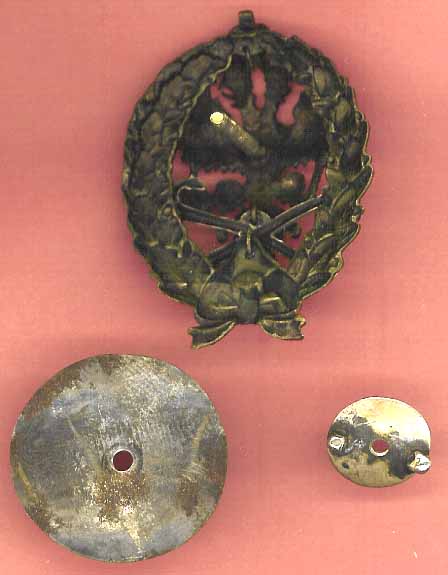

 0
0 -
Very, very nice aviation insignia. I have never seen the provisional example, even in books. Now I know of yet another hole in my collection. It's interesting that they removed the crown but retained the initial.
Chuck
0 -
Shooting and sniper awards is another area that interests me. This is the only shooting award for an officer that I have come across. I like that the dainty chain is still perfect.



 0
0 -
That's about it. Also the medals of St. George (the four-classed version, post 1878) were numbered.
It's nice too see this new forum, I too hope it grows. The imperial Russian award system is most interesting, and in my opinion these orders - especially those made pre-1914 - are amongst the most beautiful around. Too bad they command such high prizes that I can't afford buying them.
 Well.. maybe some day.. until then I'll have to settle for looking them in pictures.
Well.. maybe some day.. until then I'll have to settle for looking them in pictures.Nice examples, gentlemen.

Pete
* * * * *
PeteA
Is it your contention that all St. George Crosses had to be numbered to be legitimate? Are you sure?
Consider that it was common for private masters to make St. George Crosses on special order that were not numbered. These were worn as if they had come from government stock, assuming the wearer was entitled to the award, of course. Also, I think the base metal crosses were not well received and some soldiers, especially officers, bought precious metal versions with their own funds, if they had any.
Was it not also the case that very late-war Turkish Front "Soldiers Committee" St. George Crosses were not numbered?
Thus, might not there be examples that were legitimate but not numbered?
I think it is likely that not all authentic awarded St. George Crosses were numbered. However, I freely admit my ignorance here, and I do not claim to be an expert of any kind, merely a curious collector.
Chuck
0 -
As I heard the story, the tsar was reluctant to allocate part of his already-strained pre-war military budget to aircraft. He, like so many others, thought they had no significant military application. When WW I broke out he was way behind the power curve regarding an air force, and now his budget was really strained.
He turned to the nation's wealthy with an appeal for donations. If the donation was above a certain level, and I have been told that level was enough to buy an airplane, then the donor received one of these jetons as a token of appreciation. Or so goes the tale.
I wish I could get the whole straight story. I've got a lot of questions. My first one is, are these two different levels of the badge, one gilted silver and the other plain silver? (I'm almost positive that the one on the right is not simply one where the gilt has worn off.) If so, what were the criteria for each? How much did you have to donate? How many people did donate? Did anyone who was asked ever say "No thanks, Nicky, we've got other plans"?
Both are proofed 84. The gilt badge is hallmarked "BA" in the style of Vasili Ivanovich Andreev. My pitiful hallmark book confirms that he was, indeed, a silversmith working until at least 1917. The plain silver badge is also hallmarked with what appears to be a "BA". This mark is about half the size of the other hallmark and very difficult to read, even with a 10x glass. My eyes don't help much, either.
Very early aviation, both Imperial and Soviet, is one of my interests.
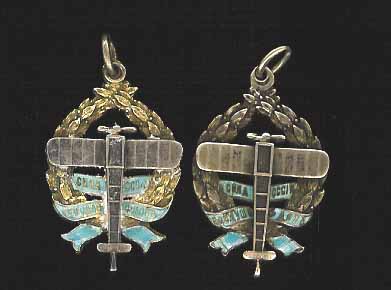


 0
0 -
The word on the badge is zakon, "law". I think this is a judge's hat badge but I'm not sure. I do know that the recipient of this badge was a judge in Batumi, Georgia. But maybe this badge was awarded to, say, government attorneys too. I bought this badge, and 1-2 pictures of the judge, directly from his descendents.
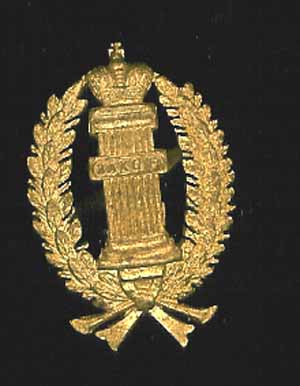
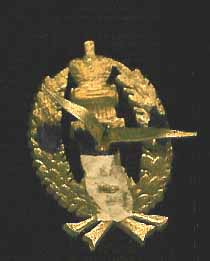

 0
0 -
<<Do you think that's what the Lt with the nurse is wearing?>>
He has a sly grin and she has major bags under her eyes. I draw no conclusions, however.
The insignia in the photo looks a little bit wide compared to my example. However, mine is the only one I have ever seen, so I have nothing else to compare it to. Surely they were made by a lot of small factories and shops who didn't have much in the way of regulations or guidance. In my heart ... yeah, thats what I think it is.
As for Zero Mostel ... that is a very cruel thing to say to a serious student of history. My sides still hurt and I'll never again see that picture without thinking of it.
Here is what a young ensign in the Imperial Air Service might have given to his sweetheart to remember him by. I have the same with three stars, but not with two.
Chuck
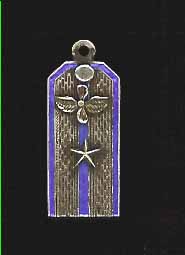
 0
0 -
My scanner gives the silver buckle a yellow hue that is completely absent in regular light. I'm not usually a uniform guy, but I couldn't let this buckle pass by. The fixtures on the back appear to be brass. The buckle is very curved, as you can see in the third image. It's in pretty good condition, all things considered.
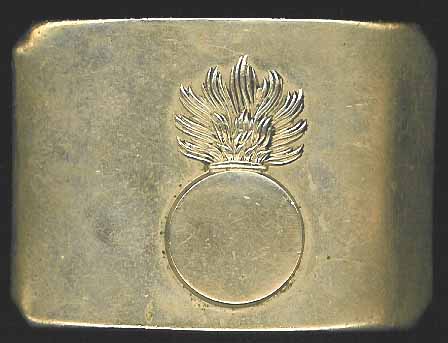
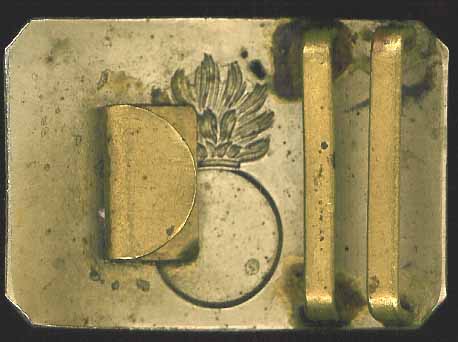
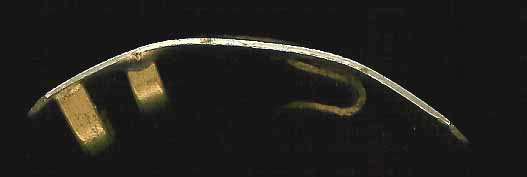


 0
0 -
The ID is pretty much all I know about this badge. A little something for Pavel before he was thrown at the Germans.
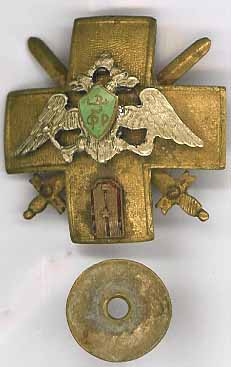


 0
0 -
<<He was a Leitenant-- perhaps of aviation branch?>>
Here is an aviation shoulder board insignia for closer comparison.
Chuck

 0
0 -
That's about all you could ask for in a late Imperial photo. Very nice, detailed and clear. I have some and I'll post a few, but yours is about as good as it gets.
I also have two small WW I photo albums, one from the CO of a mule-drawn pack howitzer unit and the other from the CO of a heavy machine gun unit. Both are from the Turkish front. I'm not yet sure how to go about copying and posting them without damaging them. I'll give that some thought.
I know that I would have bought your photo in a heartbeat if I had come across it.
Chuck
0 -
Moderators and Gentlemen
Is there any possibility of a dedicated Imperial Russia forum? What would it take? Don't these things deserve more than one posting in a continuing thread? That certainly doesn't create a good research and comparison opportunity for any award or topic.
I promise to contribute at least ten new threads within the first week to open things up if GMIC decides to create one. Anyone else? I realize that Imperial isn't the current rage, but it is darn interesting and varied and it offers a lot of collecting opportunities for less than, say, the latest prices for equivalent Soviet or Third Reich awards. The market seems wide open to me, but what do I know? Still, inquiring minds want to know.
Chuck
0 -
OK, one more tonight.
I'll likely never have an Order of St. George breast badge, but I do have this frachnik, or miniature, of one for wearing on other than a uniform. This one is both proofed and hallmarked. The letters may once have been gilted but they don't show any remaining traces under my 10x glass, only the silver beneath. In contrast, the two circles have perfect gilt, enough so that I wonder if they are really solid gold. The pin on the reverse is still tight and functional, although I don't tempt fate by playing with it.

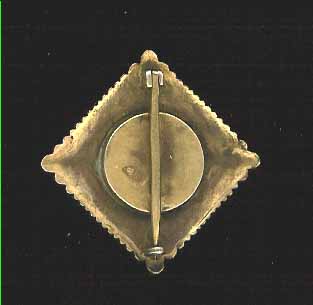

 0
0 -
And here's the reverse of the Transition Government St. Stan-2.
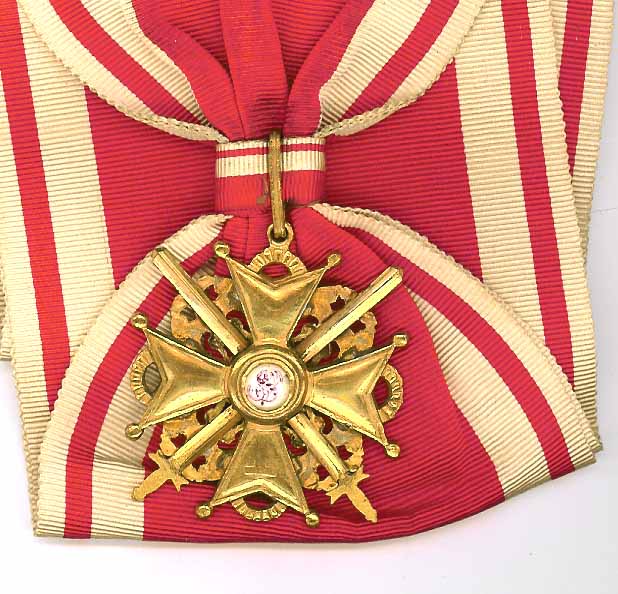
 0
0 -
Here's a Transition Government St. Stan-2. No crowns on these, the better to maintain the fiction that really, not that much was going to change, I guess. Military version, of course, with swords.
Note the major differences in the style of leaves on the obverse, comparing this to the previous one. This is a very nice example of this variation, IMHO.
The large ribbon is wrong. You probably know that. It is the ribbon for a first class. The family I bought this one from insisted that the recipient also had a first class but they had sold it. Who knows? Anyway, they did have this ribbon. Later on, they called and said they had the second class ribbon, if I wanted it. That's the one you see in the previous post.
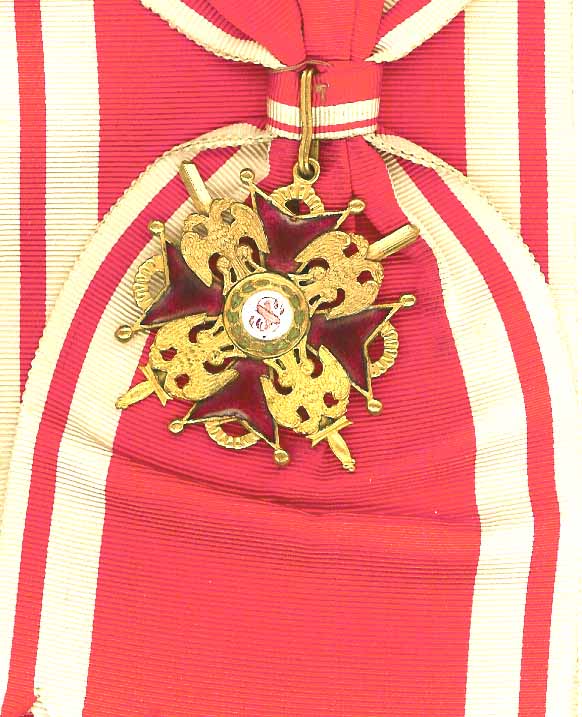
 0
0 -
Now THAT'S what I'm talkin' about!
OK, here's a late pre-Transition Government St. Stan-2nd, military only of course by then, with swords. Gilt over bronze, I think. That's the correct smaller ribbon, but it came out of another set.
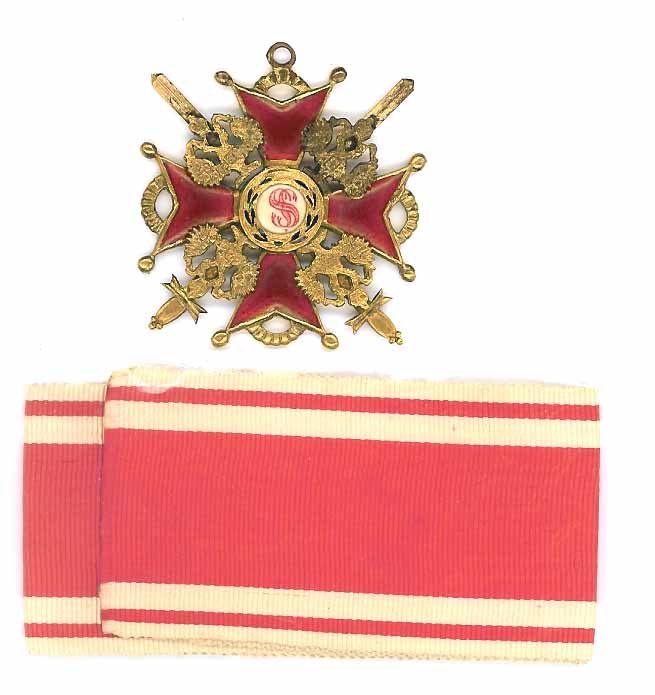
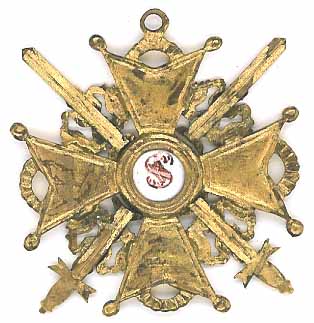

 0
0 -
Good afternoon
I am pretty new to GMIC and this is my first time in this forum. I have already posted a few Soviet badges in that forum.
I have collected a lot of Imperial Russian items over the past several years and I was hoping to find an active interest in that topic. To the best of my knowledge, there isn't an active forum devoted to Imperial Russian militaria and collectibles anywhere. Too bad. That's something I would enjoy seeing, participating in and learning more about.
Regardless, I'll start my contributions off here with a couple of Orders of St. Anna, 4th and 3rd classes, military versions with swords, late-era gilt over ... over what? For the swords and filigree, probably brass, maybe bronze. For the metal of the crosses themselves, both crosses are hallmarked and the metal underneath the red enamel is grey, as you can see. I suppose it could be silver but I just don't know. These aren't pristine, of course, but they're good enough for me.
If the interest is here and others will post a few things, I'll be glad to contribute my own modest collectibles for your enjoyment.
georgecl, #84503 is about as nice a late St. George Cross-3rd as anyone will ever see. Good find.
Kindest regards,
Chuck
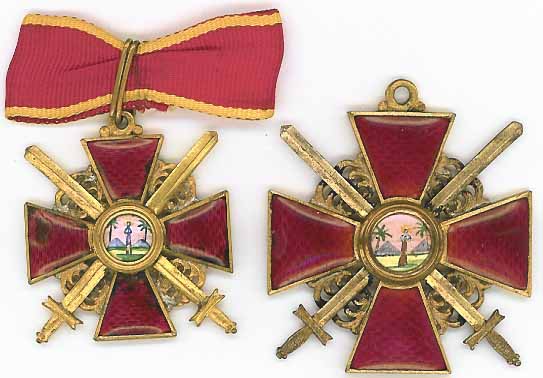
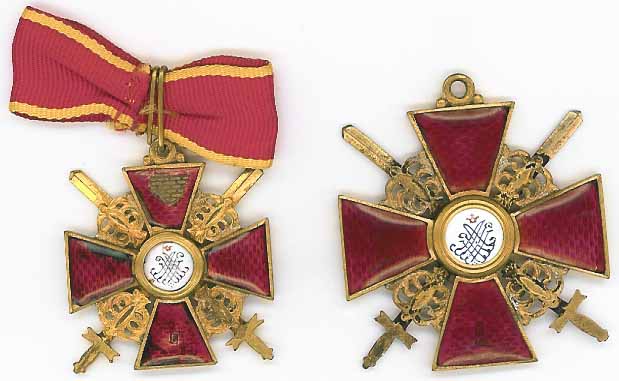

 0
0 -
I like this early little badge a lot, but I don't have a clue as to what it really is. If you do, please share your knowledge.
Check out the details closely. There is a band saw on the right and a prominent axe (really an adze, I think, for shaping wood rather than, say, tree falling or trimming). There is also what looks like a lever with a round end just to the right of the adze head, signifying who knows what.
The guy on the badge is using what appears to be a heavy, old-style all-wood plane to shape a beam. He is wearing what I would call a shop apron over a long-sleeved shirt with rolled-up sleeves. He is also wearing something (goggles, dust mask, I can't really tell) that he has pushed up above his forehead.
The shavings coming off of the planed beam seem to make four stylized letters. Unfortunately, I can't make out what the letters are, so I don't have a clue what they might stand for. They look more like Latin letters than Cyrillic. Behind the adze, saw and letters is a large round saw blade, like the kind found in saw mills, and there is a two-man saw, probably for cutting boards rather than, again, for falling timber. You can see the round saw blade's teeth at the bottom and above, behind the letters, and the individual teeth on the two-man saw.
Just as an aside, you can still see men in the third world making lumber out of logs with two-man saws like the one on the lower left edge. One guy, obviously the junior partner, stands down in a trench and the log is placed lengthwise on top of the trench. The second guy, on top, helps to position the saw and start the cut and then they start two-man push-pull sawing down the log, with the sawdust, dirt and sweat falling all over the lower guy in the trench. Interestingly enough, they can cut some pretty decent lumber that way, certainly good enough to plane to size. But I digress.
The nut is cheap but kind of unusual and may not be original. The insignia at the top is common enough, as is the red enamel with the rays underneath. The metal seems to be plated bronze or brass. Now check out the big building. Each of the windows contains a separate spot of blue enamel. I was amazed when I realized that. With the smoking chimneys it must be a factory of some sort, maybe related to lumber production or something like that. And did you notice that the details of the head of the band saw are made with four squares of black enamel?
And what about the rectangular compartmentalized whatever-it-is on the left, as we look at the badge. What the heck is that? It looks to me like something in a building in large stacks and there appears to be black enamel between the stacks. My guess is ... a wood drying kiln. Your guess will be equally valid and likely more so.
OK, enough of my droning about one old badge, but this is one of the busiest and most interesting small badges I have ever seen. I can't imagine going to all that trouble just to make one small badge. It's just that this one has always intrigued me and I wanted to share it. Enjoy.
Chuck
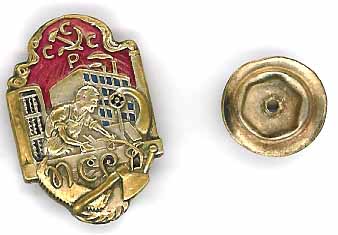
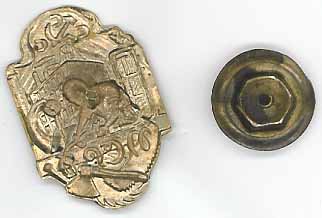

 0
0 -
Thanks, Jan. I thought they were veterans' badges, not official medals. However, these particular ones have a very notable provenance, so that's something I should have imagined.
Chuck
0 -
Here are a couple of Mongolian badges. I apologize for obscuring the name of the recipient.
Chuck
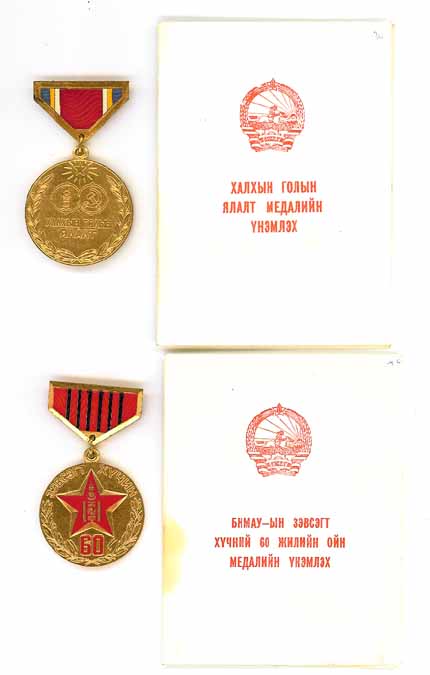
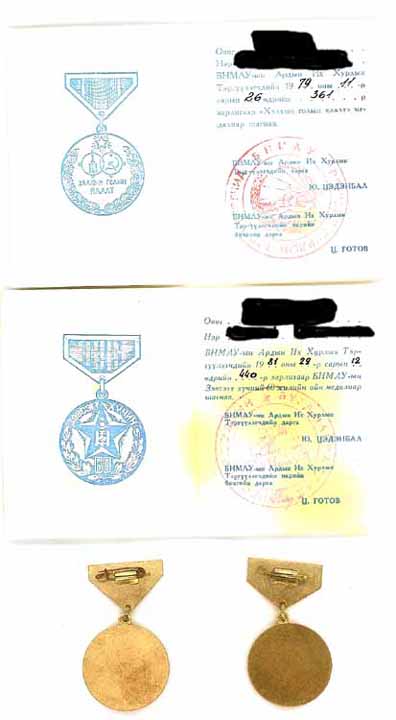

 0
0 -
Nice find indeed. Would this badge have been awarded as a MVD award?
* * * * *
Although Soviet state security is a fascinating field, I am by no means knowledgeable regarding it. As I understand it, the Imperial MVD died a violent death during and right after the revolution. It, and the Okhrana, were replaced by the Cheka-GPU. If I'm not mistaken -- and I welcome correction -- the modern MVD was reconstituted out of the NKVD in 1946 when Narkomats gave way to Ministries.
So, a Chekist-GPU award, but not MVD ... I think.
Just my two cents, and worth every penny.
Chuck
0




Alexander's Military School Graduate's Badge
in Russia: Imperial
Posted
Heavy bronze (or brass), two pieces, pre-WW I, I think. There is one in Avers 3, item 284, that they date to 1909.
But ... who in the heck designed that oh-so-ugly eagle feeding her chicks in the nest, the center design of the badge? I mean, come on. Yeah, I get the symbolism, but that is one bad, bad design. It kinda looks like a Hydra, or maybe a pelican, or a winged snake about to eat the little guys. I bet the cadets from the other academies ragged them mercilessly.
Chuck